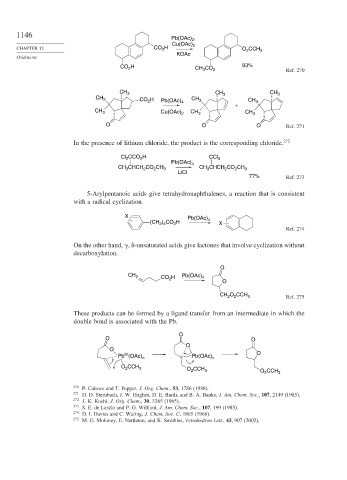Page 1170 - Advanced Organic Chemistry Part B - Reactions & Synthesis
P. 1170
1146
Pb(OAc) 2 ,
Cu(OAc) 2
CHAPTER 12 CO 2 H O CCH 3
2
KOAc
Oxidations
CO H CH CO 2 93% Ref. 270
2
3
CH 3 CH 3 CH 3
CH 3 CO H Pb(OAc) 4 CH 3 CH 3
2
+
CH 3 Cu(OAc) 2 CH 3 CH 3
O O O Ref. 271
In the presence of lithium chloride, the product is the corresponding chloride. 272
Cl 2 CCO H CCl 3
2
Pb(OAc) 4
CHCH CO CH CH CHCH CO CH
CH 3 2 2 3 3 2 2 3
LiCl
77% Ref. 273
5-Arylpentanoic acids give tetrahydronaphthalenes, a reaction that is consistent
with a radical cyclization.
X Pb(OAc)
(CH ) CO H 4 X
2 4
2
Ref. 274
On the other hand, -unsaturated acids give lactones that involve cyclization without
decarboxylation.
O
CH 2 CO H Pb(OAc) 4
2
O
CH O CCH 3 Ref. 275
2
2
These products can be formed by a ligand transfer from an intermediate in which the
double bond is associated with the Pb.
O
O O
O
O O
IV
Pb (OAc) n Pb(OAc) n
O CCH 3 O CCH 3 O CCH 3
2
2
2
270
P. Caluwe and T. Pepper, J. Org. Chem., 53, 1786 (1988).
271 D. D. Sternbach, J. W. Hughes, D. E. Bardi, and B. A. Banks, J. Am. Chem. Soc., 107, 2149 (1985).
272
J. K. Kochi, J. Org. Chem., 30, 3265 (1965).
273 S. E. de Laszlo and P. G. Williard, J. Am. Chem. Soc., 107, 199 (1985).
274 D. I. Davies and C. Waring, J. Chem. Soc. C, 1865 (1968).
275
M. G. Moloney, E. Nettleton, and K. Smithies, Tetrahedron Lett., 43, 907 (2002).

